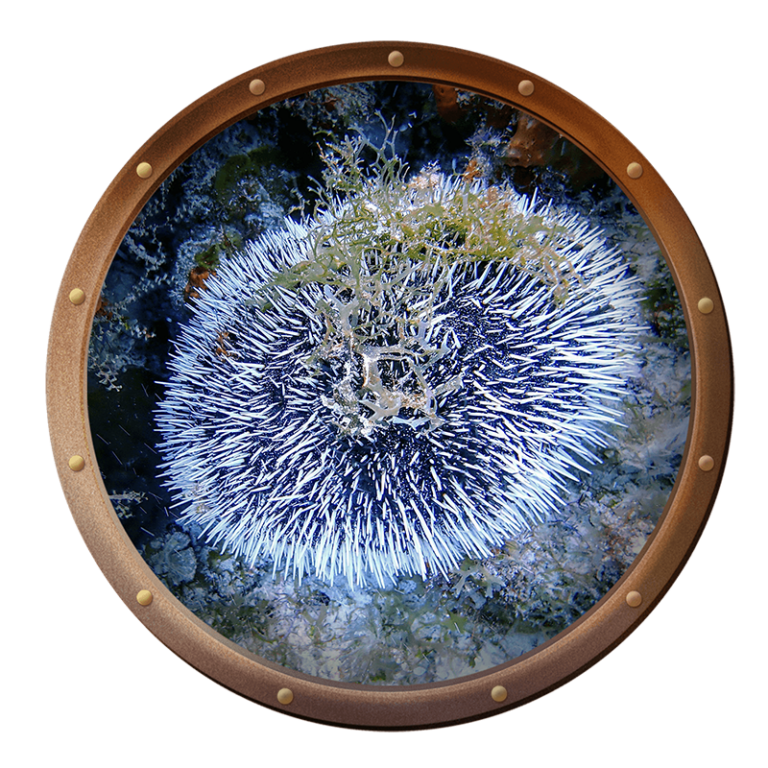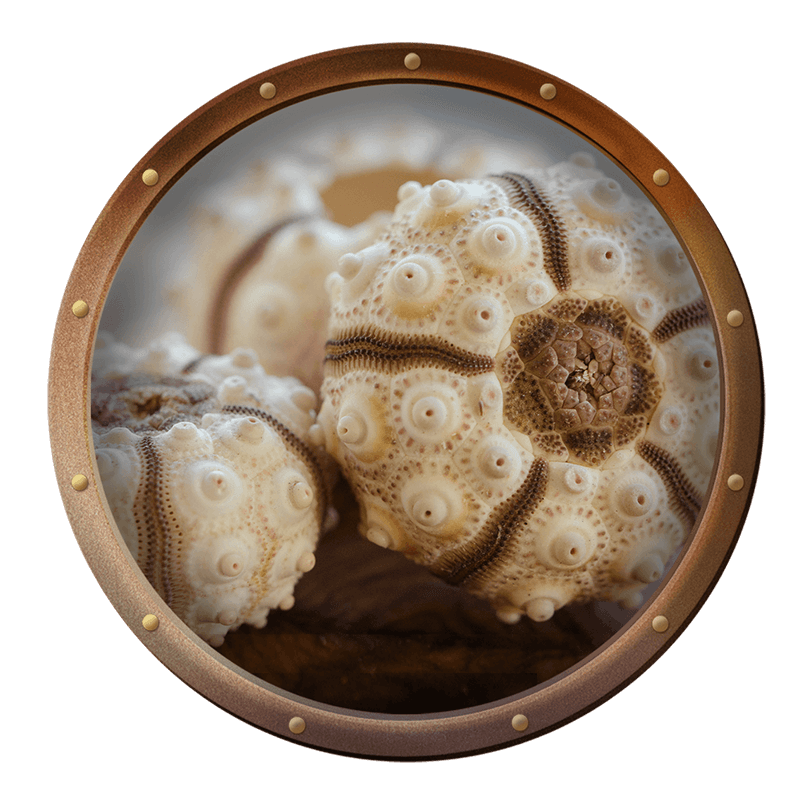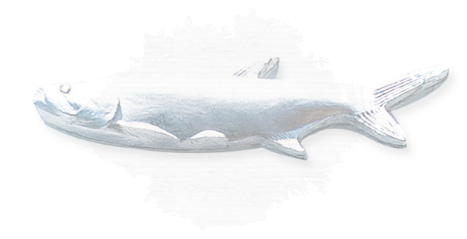Sea Urchins
There are over 900 species of sea urchin inhabiting all the world’s oceans, from intertidal coasts to over 16,000 feet deep. These animals are ancient, first appearing over 450 million years ago in the Ordovician Period. Sea urchins are echinoderms, in the same phylum as sea stars, sea cucumbers, and sand dollars. The word “echinoderm” is derived from the ancient Greek word for “spiny/hedgehog” and the Latin word for “skin,” and it is easy to see how this name was chosen when looking at an urchin. While they bear very little outside resemblance to their sea star relatives, their body plan and biology are actually very similar.

Sea urchins have an endoskeleton called a “test.” This structure is made of calcium carbonate ossicles (plates) that are fused together. Urchins have pentametric radial symmetry, five sections that radiate from a central point. The test houses the sea urchin’s organs and provides attachment points for the spines, which are mobile and can be used for moving, anchoring or as a defense. The spines are connected by soft tissue to the test and fall off when an urchin decays, leaving a hollow globe that can be hard to recognize as an urchin.
How Do Sea Urchins Move?
Sea urchins have a water vascular system that they use for movement. Water enters through the madreporite, a specialized porous ossicle on the top of the urchin, and passes through a series of canals in the body. Movement is generated by hydraulic pressure, pumping water into and out of the tube feet that adhere to surfaces, and movement of the spines. Tube feet cover all sides of the urchin, and some may be used to hold objects on top of the animal for camouflage, while others are used for walking.
Some species, like the variegated urchin (Lytechinus variegatus), are commonly called “collector urchins” for their tendency to do this. This individual is using seagrass, shells, and even the skeleton of another urchin for cover!

How Do Sea Urchins Eat?
Sea urchins have a unique feeding structure known as an Aristotle’s Lantern. The ancient Greek philosopher Aristotle wrote about natural history in addition to philosophy. He studied and described many animals in his book “Historia Animalium” or “The History of Animals.” It was in this work that he described the mouth anatomy of the sea urchin as looking like a type of lantern commonly used in ancient Greece. Later scientists who studied these works used the term Aristotle’s Lantern to describe the mouth parts of the urchin, and the term is still in use today. Muscles are attached to the bony structures that end in teeth. The sea urchin uses these to scrape and pull at food, taking bites that pass into the digestive system.
This amazing structure has even inspired scientists designing equipment for use in space!
How Do Sea Urchins Reproduce?
Sea urchins are dioecious, having both male and female individuals. They reproduce by spawning, releasing sperm and eggs into the water column where they mix and fertilize. The first part of development occurs in the water column: the larval urchins are part of the plankton and look a bit like a lunar lander. The larvae go through metamorphosis to assume their adult form, which settles on the bottom.
What Are Threats to Sea Urchins?
Once sea urchins reach adulthood, there are not many threats to their survival, and they may live to be over 100 years old. Some creatures prey upon sea urchins, such as the queen triggerfish in the Florida Keys. The sea otter is a sea urchin predator in the North Pacific, and the decline in their numbers has led to plague-like proportions of urchins who feed upon the kelp. Humans are sea urchin predators as well! The eggs are consumed as a popular sushi dish, and harvesting of overpopulated sea urchins for food can be an effective management strategy.

In addition to predation, sea urchins are vulnerable to diseases. In 1983, a mysterious disease caused a massive die-off of Diadema antillarum in the Caribbean. In just 13 months, 98% of the population of these urchins died. The cause is still debated, but the result was a major shift in the ecology of the reef. This species was largely responsible for controlling algae on the reef, and its abrupt absence resulted in less coral cover and more algae. A similar event was observed in 2022 around the island of St. Thomas. This time, scientists were able to respond quickly to take samples and test the urchins in the lab to pinpoint the culprit. It seems a microscopic protozoan parasite called a scuticociliate was to blame. The outbreak seems to have died down, and it is not clear if this was the same cause of the 1983 outbreak, but it is very likely.
Conservation efforts are underway to restore Diadema antillarum to the damaged reefs of the Florida Reef Tract. The process of raising urchins in a laboratory setting was pioneered by Florida Keys resident and aquaculture legend Martin Moe.

Are Sea Urchins Dangerous?
Sea urchins are famous for their spines, and some of these can be quite sharp. Spines may break when they puncture skin, leaving a foreign body behind that can cause infection and inflammation. Some species of sea urchins are venomous as well. Fortunately for visitors to the Florida Keys, those species are from the Indo-Pacific and not found here. It is always recommended to wear water shoes when you are walking in the ocean. This will not only help prevent injuries from urchins but also keep feet safe from sharp rocks and other stinging animals that live on the bottom.

What Types of Sea Urchins Are in the Florida Keys?
Long-spined urchin, Diadema antillarum
This is a protected species in Florida, and it is a great sign if you see it! Be sure to keep your distance; the spines are sharp, brittle and tend to break into pieces if they puncture skin. The spines may be black, white or a combination of the two.

Reef urchin, Echinometra viridis
This species has thick pointed spines with a distinct ring of white around their base. They are nocturnal and tend to inhabit shallow coral reefs but may be found in red mangrove roots as well.

Rock boring urchin, Echinometra lucunter
This species bores holes into rock and hard substrate where they spend the day. They are often found in rocky tidal areas but can live down to 150 ft on the reef.

Variegated urchin, Lytechinus variegatus
This species is also called a decorator or collector urchin for its tendency to carry objects. These are used for camouflage as they roam sand and seagrass habitats looking for food. They have short spines that come in a wide variety of colors, including red, purple, green and blue.

West Indian sea egg, Tripneustes ventricosus
This species has an egg-shaped reddish-brown body densely covered in short white spines. They typically stay in shallow areas with seagrass, which is often held by the urchin for shade and camouflage.

Slate pencil urchin, Eucidaris tribuloides
This species is named for its thick blunt spines. The spines of the red pencil urchin were actually used as writing utensils by native Hawaiians. These urchins use their thick spines to anchor themselves into crevices on the reef during the day. This species is a resident of the Touch Tank at the Key West Aquarium!





